
|  |

|  |
 e-mail: khokar1960@gmail.com Ekah! Photos courtesy: Nad Roop February 16, 2024 Ekah danta... runs the stuti on Ganesha.... But in dance finding qualified soloist of substance is not easy. It calls for minimum twenty years of work: Five years foundation, five in training, ten in performing experience professionally. So average is forty by the time one reaches national stage. By then either half have married or have families or no possibility to stay with the dance. 40-60 is the best run for a soloist, other things being equal. The art of the soloist had steadily been on the decline, especially in Kathak. Bharatanatyam has enough volume so staying power is equal. Orissi is fifty-fifty. Group works is the vogue. It is so, as a teacher can show many students on stage at one go. The guru today is just a title, mostly. Solo training means focused attention. Teachers have assembly like training. Solo art is all but diminished. Reasons are many: first of all, gurus are not gurus but mostly art-teaching schools. More the number of students, more the earnings, outreach and social standing. This leads to a rather flimsy foundation. Gurus or teachers say parents are more ambitious and force them to fast-track and do debuts quickly so their ward arrives on the scene quickly! That helps visibility if not marriage market. Lastly, the students themselves. They change gurus like they change wardrobe or hair styles. Some are caught between wanting to be successful and stars while some think they are born stars. 5k followers on social media make them feel they have arrived. They don't have the staying power to learn to talk first before learning to dance first. Social media and self-reviews give most a fake sense of belief that they are good or worse, relevant. End result of above three: sub-standard end result, shows to empty halls and no real professional standing. No solos for sure. Which is why seeing several first rate solo dancers in two main forms of Western and Northern India - Bharatanatyam and Kathak- one felt rewarded and glad for the art. Guru Shama Bhate first. She had none of the trappings of gurudom but her flock loves her. Low key, elegant of mind and deed, cultured and refined she presented 3 days of ten soloists and one felt Indian classical dance of Kathak still had some theraav, repose, silence between pauses, left. No hurry burry, no short cuts, no stress. Each day of the Sanchit festival (Bal Shikshan, Pune) established the guru's training, wards' hard work and seriousness of purpose. Guru Shama Bhate is clearly ahead of the pack of kathakaars that abound in Pune. There are others equally active but she has an understated academic approach to art, mind over matter. She has what many lack: Arjun's eye on the eye of the fish. If you don't know the parable then you are not seriously into Indian arts based on mythology. 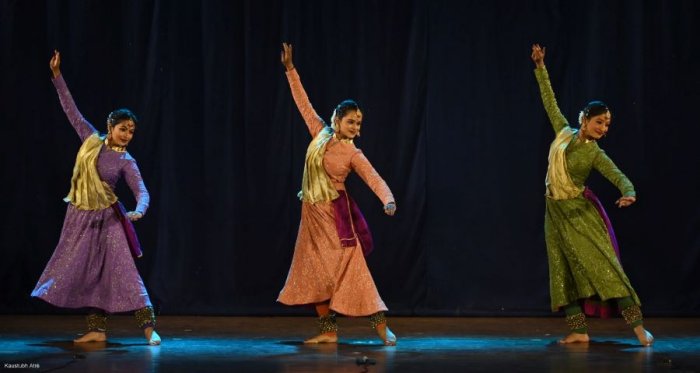 Kathak trio Starting the festival of soloists with a trio sounded anti concept but as the three days festival progressed, one could see why. The reason was a slow acceleration from youngest to eldest; buds to bloom. Hence these three - Esha Nanal, Shraddha Mukhade, Shreya Kulkarni - got enough solo sections to prove their worth. Starting with a Krishna vandana, in madhya laya teental, interwoven with a Tarana in raga Hameer in drut laya they set the inaugural tone. Tabla by Ishan Paranjpe was in fine fettle, with vocals by Shubham Khandalkar. On the harmonium was Soumitra Kshirsagar and padhant by S.Bhide was clear. Flute of Sandeep Kulkarni made one in touch with the supreme. Here's a senior talent deserving of a national award.  Shivani Karmarkar 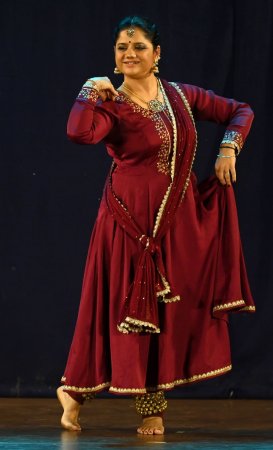 Mukti Shri Then, as stated, each showcased individually so Shivani Karmarkar undertook Taal Panchamsawari (15 matra) in which aspects of Kathak performance shone. Tabla by Charudatta Phadke, harmonium by Yashwant Thitte, vocals by Suranjan Khandalkar, flute again by Sandeep Kulkarni and padhant by Ameera Patankar were well enunciated. Mukti Shri's Vandana was an obeisance to Lord Rama, in rupak tala and the concluding Bhajan - Vishnumaya Jaga - of Sant Tukaram was layered in drut teentaal. That a giant tabla maestro Yogesh Samsi accompanied her and truly did sangat (never dominating and in one instance also seeking her permission to play!) showed how a fruit laden tree always bows. Vocals by Nagesh Adgaonkar and harmonium by Abhishek Shinkar were of high class. Flute by Sandeep Kulkarni was again soulful. Padhant by Anvi Shri was well articulated. 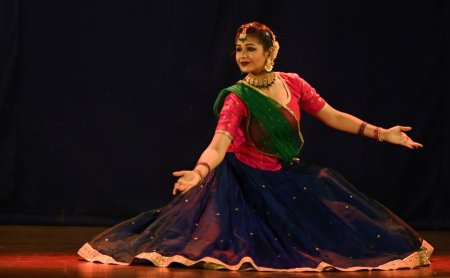 Avani Gadre 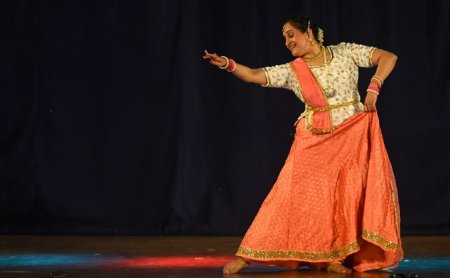 Leena Ketkar Day 2 brought Avani Gadre doing Devi Vandana set to Ashtamangal tala of 11 beats dovetailing in Gat bhaav. Nandanaar, the story of the hunter perceived as low caste was not allowed in the temple and pleaded to Nandi to get out of his way so he could see Shiva. Avni was not in her customary element and often lacked finish and the costume colours were a bit garish. Tabla by Aashay Kulkarni, harmonium by Saumitra Kshirsagar, vocal by Vinay Ramadasan, flute by Sandeep Kulkarni and padhant by Esha Nanal gave adequate company. Leena Ketkar next did Vandana set to 7.25 matra, an abhinay exploring Karna. This was a well etched cameo with detailing and finesse. Tabla by Charudatta Phadke, harmonium by Yashwant Thitte and vocals of Mayur Mahajan were good support. Flute again by Sandeep Kulkarni made it a mini Sandeep Kulkarni festival! Padhant by Ketaki Shah were good. 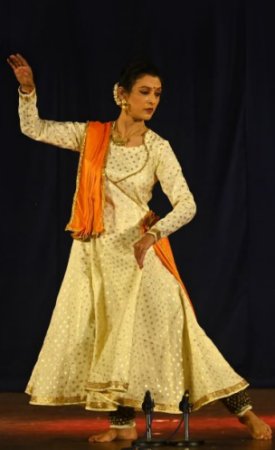 Sheetal Kolwalkar  Ameera Patankar Sheetal Kolwalkar's Ganesh Vandana in Taal dhamaar was composed by her, that's an achievement! It also shows guru Shama Bhate's training that gives a solid foundation. A guru gives equally; what a student makes of these gifts is individual patrata (capacity and ability to observe, absorb and acquire). Krishna bhajan concluded the evening. She composed the Vandana, Ganesh Paran, and Dhamaar Bandish. Wow! So young and so much material. Her two pakhawaj players Shubham Ugale and Omkar Dalvi added a huge effect and depth to the sangat even if the mic of one kept hitting the other. Why the other musicians couldn't move an inch was beyond me. No empathy for fellow musicians on stage. Day 3 proved the adage less is more. Marred by a sudden knee lock, Ameera Patankar's Guru Vandana started off ably and her hastas alone dance. Next time you watch her dance, just see her hands dance. She also proved one doesn't have to eat a whole mound of rice to know if it is cooked or not. Tabla by Charudatta Phadke, harmonium by Mandar Dixit, vocals by Vinay Ramadasan and flute by Sandeep Kulkarni gave able support. 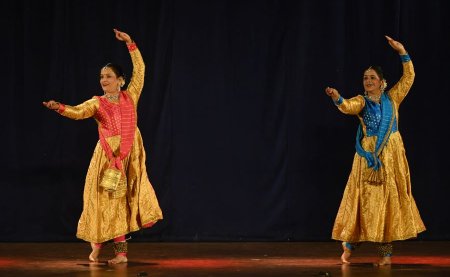 Sheetal Kapole and Shrikala Joshi 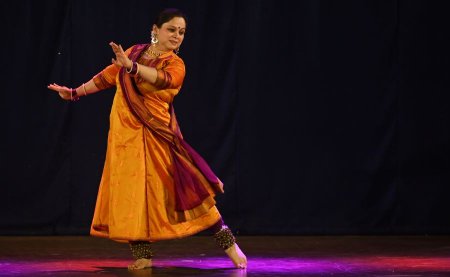 Ketaki Shah Sheetal Kapole and Shrikala Joshi undertook Devi Vandana in Tishra teentaal. Abhisarika nayika, bandish by late Dr. Prabha Atre, Kaise jaun milan piya ri was rather literal, proving once again that abhinaya can't really be taught; it comes with age and life experience. Tabla by Swapnil Bhise was of high order. Harmonium by Mandar Dixit, vocals by Shubham Khandalkar, flute by Sandeep Kulkarni (who else?) and padhant by Ananya Govitrikar completed the accompanying artstes. Ketaki Shah's Tridevata Stuti had unbridled energy that dovetailed in Ganesh-Devi-Shiv Vandana cum Kavit inbetween composed by her in Ada chautaal. Abhinaya to Kitak din Hari sumiran bin khoye was passable. Tabla by Ramdas Palsule, harmonium by Saumitra Kshirsagar, vocals by Suranjan Khandalkar, padhant by Leena Ketkar platformed Pune's claim to high quality Hindustani musical fame. It was left to Manasi Deshpande to make even Shiva smile and shine with her 1000 watt stage persona. What a natural performer. She uplifted the three days' solo festival to another level. Through laya sopan she explored through 5 Jatis. Tabla sangat by Swapnil Bhise was apt and harmonium and vocals by Somnath Mishra pleasing. Flute by the one and only permanent musician on stage in the three days festival - Sandeep Kulkarni- made us feel the instrument. Padhant by Ananya Govitrikar, a youngster, was well done. Manasi's abhinaya Thumri was understated and elegant. Her spirit soars and she made one believe that Kathak need not be heavy but happy making. The entire festival was happy making. This festival also proved that while the official Kathak Kendra is in Delhi, the real Kathak ka kendra or centre is now Pune. Shabash, all! 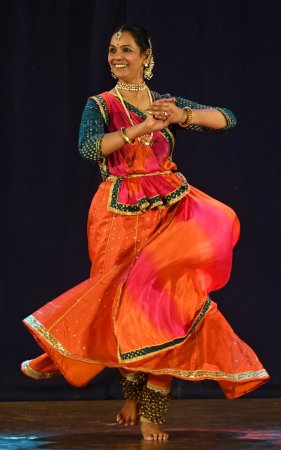 Manasi Deshpande 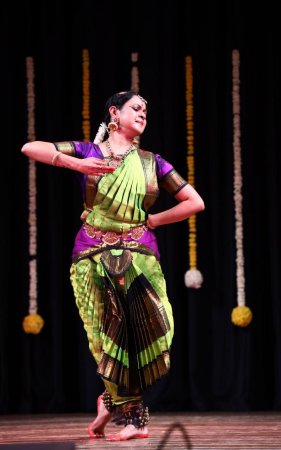 Arupa Lahiry Next Baroda and Bharatanatyam solo by Arupa Lahiry. Where was she all these years? Now coming up nationally, this was a show that showed three things: how to innovate within tradition without sacrificing content, intelligent choreography and thirdly, smart item choices. A well curated and executed show. Let's start with the first item Anjali. Smart choice because the festival she performed in was dedicated to the memory of Anjali Mehr of Baroda MSU dance dept. When the founder head Prof. Mohan Khokar left after 12 years in Baroda for Delhi SNA, Anjali ben became the head. Coincidentally she and Mohan Khokar were together in Kalakshetra at the same time, 1944-47. He left because India was partitioned and his family in Punjab had to flee for life and come to Meerut, then Ambala, finally settling in Chandigarh. Rest of India danced on without suffering much, only Bengal did too. Arupa Lahiry mentioned princess Chimanbai in passing when she introduced the second item on cupid. History says Srimant Maharaja Gaekwad III couldn't find a bride that suited his horoscope so emissaries were sent far and wide up to the Maratha empire in Tanjore. There a perfect match was found and with her royal dowry came a set of dancers and musicians. Two of such devadasis were Kantimathi and Gowrima. They entertained the court. See the cover of attenDance Gujarat issue done 20 years ago! That's the royal durbar scene with dancing devadasis.  So to create a whole new varnam - the most demanding item in Bhararanatyam repertoire - fresh from a scratch showed Arupa Lahiry's research ability and artistic quest. First rate. Well etched. A dancer that knows what's her threshold in stamina for this longest item of the evening is a sensible dancer. Where Arupa excelled was in well etched cameos. Clarity is hallmark of her delivery. No need to impress. Just be and do well. Economy of movements and sculpturesque poses helped give quiet spaces. There was stillness in movement. That's not easy. To dance is easy, to be still on stage is not. The concluding piece on Panduranga showed her ability to sustain audience interest while taking them with her on this devotional trip. A first rate professional performance that suits well for Arupa, ably supported by a team of musicians from Delhi. Vocal was by saintly voice of Venkateshwaran Kuppuswamy, nattuvangam by Varun Rajasekaran, mridangam by Manohar Balachandirane - bit loud - and violin by youngster G Raghavendra Prasad. 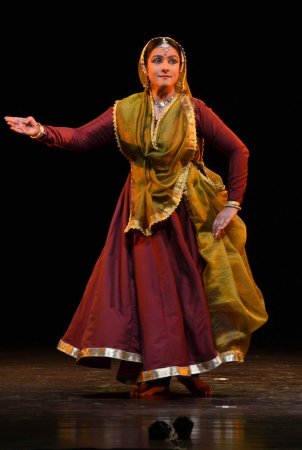 Parwati Dutta 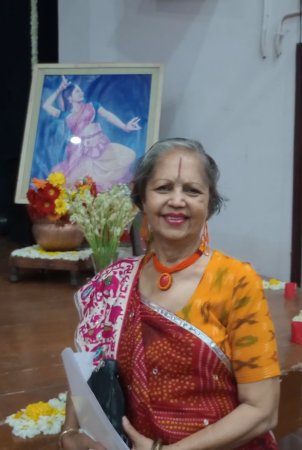 Parul Shah From Aurangabad came another soloist, the academic Kathak dancer Parwati Dutta. The depth of art, her literary mind and scape, perfect tayari and masterful structuring showed why she has gone far in art - literally. She created an institution of excellence in wilderness of that region and has imparted training to many. Manoj Das sang like Yesudas' voice and Charudatt accompanied ably on the tabla as did the sarod vadak. Parwati Dutta has theraav and tayari, two pillars that give Kathak its personality, so missing these days. Narthaki Nataraj concluded with her Kittappa Pillai baani fare, tight and taut and full of substance and structure. Thanks to Parul Shah of Baroda, the three solo gems could be seen at her annual festival Nrityaparva. 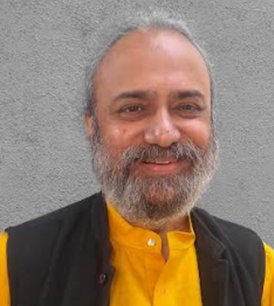 Critic, connoisseur, historian, author, artivist, archivist, administrator and more - editor, columnist and mentor Ashish Khokar remains true to his muse. More on attendance-india.com Response * Having known Ashishji since I was in my early teens, I have grown from being scared of his presence to respecting his honest unfiltered opinions over the last three decades. In today's day and age, when all criticism is but commercial, his comments emerge as heartfelt and very close to the truth of an artist's path. Needless to say, his encouragement means a lot and those who take his criticism in the right spirit, stand to gain much more in their artistic journey! - Rashmi Singh, BN dancer, Delhi (Feb 17, 2024) Post your comments Please provide your name and email id when you use the Anonymous/blog profile to post a comment. All appropriate comments posted with name and email id in the blog will also be featured in the site. |